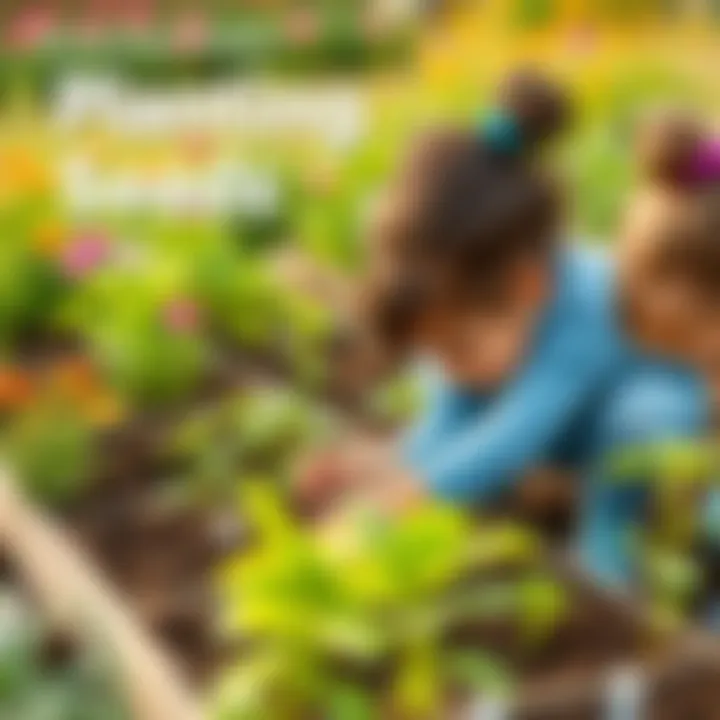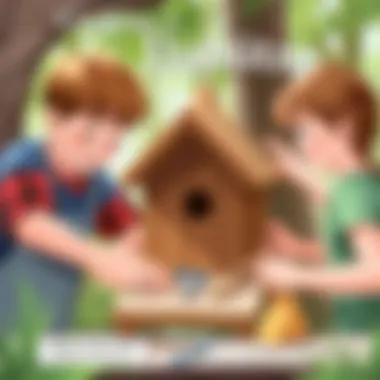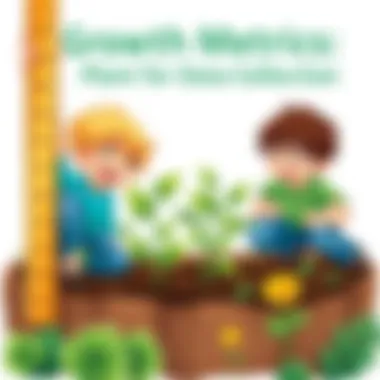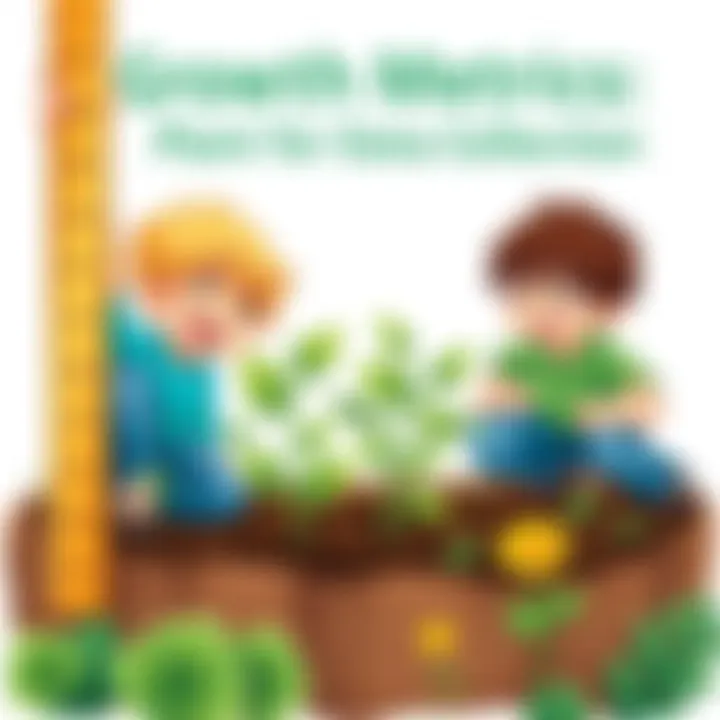Engaging Garden STEM Projects for Young Learners


Intro
In today's world, where technology dominates and educational methodologies evolve at breakneck speed, it's crucial to find ways for children to connect with nature while fostering their intelligence and critical thinking. Garden-based STEM activities offer a unique convergence of learning and the great outdoors, creating an ideal backdrop for engagement. These hands-on projects, rooted in science, technology, engineering, and mathematics, not only make lessons interactive but also spark curiosity. This article is designed to illuminate the vibrant world of garden STEM activities tailored for younger minds, providing a robust framework for parents, educators, and caregivers. With a mix of research-backed insights and practical suggestions, we aim to inspire the next generation of thinkers and innovators through the wonders of gardening.
Interactive Learning Games
Engaging children through play is one of the most effective learning strategies. Interactive games, particularly those that can be adapted to a garden context, not only stimulate minds but also encourage teamwork and problem-solving skills. By embedding educational content into games, kids develop essential cognitive abilities while having fun in the fresh air.
Popular Games
A few games stand out for their educational value and engagement level:
- Garden Scavenger Hunt: Kids search for specific plants or insects, learning to identify biodiversity.
- Nature Bingo: A bingo card filled with items found in the garden encourages observation skills.
- Planting Pictionary: Children draw plants or gardening tools, prompting discussions around their uses and values.
Description of Top Educational Games
Games like Garden Scavenger Hunt help children develop their observation skills and knowledge about various species. Each round brings excitement, but also a mini-lesson on the importance of biodiversity and ecosystems. Meanwhile, Nature Bingo serves to enhance focus and attention to detail as they race to mark off their cards in a vibrant environment.
Benefits of Playing Educational Games for Kids' Cognitive Development
The benefits of such games are extensive. They:
- Foster teamwork and collaboration among peers.
- Enhance critical thinking by prompting kids to make connections.
- Improve fine motor skills through activities like planting or drawing.
Game Reviews
Individual assessments of these games reveal a wealth of learning opportunities:
- Garden Scavenger Hunt promotes engagement with the ecosystem directly, teaching children about flora and fauna.
- Nature Bingo encourages visual literacy and improves memory retention.
- Planting Pictionary acts as a catalyst for discussions around what those drawings entail and their relevance within both a garden and broader contexts.
Comparison of Gameplay and Learning Outcomes
When comparing these games, Garden Scavenger Hunt stands out by providing a holistic experience where children touch, feel, and see live components of their environment. Meanwhile, Nature Bingo effectively reinforces memorization and encourages friendly competition, making learning enjoyable. Finally, Planting Pictionary elicits creativity and imagination, leading to deeper conversations about nature.
Educational Topics
For a complete understanding of how each STEM element ties into gardening, a collection of articles covering various subjects can be very useful. Learning about math concepts through gardening helps children see real-world applications of numbers and measurements. Science lessons derive directly from planting schedules or observing growth cycles; a rich interdisciplinary approach enhances children's developmental pathways.
Importance of Interdisciplinary Learning for Holistic Development
Incorporating various educational subjects into garden activities aids in building a well-rounded knowledge base for kids. When math, science, and art converge in an outdoor setting, critical thinking is nurtured, demonstrating how interconnected all fields can be.
Tips and Tricks
To maximize the benefits of garden STEM activities,
- Create a dedicated gardening schedule to keep kids engaged throughout the growing season.
- Encourage open-ended questions during activities to stimulate inquiry and discussion.
- Use collective challenges, like growing a specific plant from seeds, to encourage teamwork.
Practical Tips for Parents and Educators to Enhance Children's Learning Journey
Setting realistic objectives for each activity can help measure growth and understanding. When kids work toward tangible outcomes, they build both self-esteem and a sense of achievement.
Strategies for Making Learning Fun and Engaging
Rotate responsibilities within the garden tasks, assigning roles based on interest, so every child feels valued in this learning environment.
Creative DIY Projects
Making things with your hands is a genius way to tie creativity into learning applications. Children love to see their ideas come to life, and DIY projects in the garden spark imagination and offer lessons on planning and execution.
Step-by-Step Guides
Creating simple DIY garden projects might include:
- Building a Birdhouse: Children learn measuring and construction.
- Creating Seed Bombs: Mixing seeds with clay and compost for a hands-on learning experience.
- Starting a Compost Bin: Teaching sustainability and decomposition.
Benefits of Hands-On Activities for Children's Cognitive and Motor Skills
These projects enhance both fine and gross motor skills as children manipulate tools in a natural environment. Moreover, problem-solving skills come into play, as tweaks and adjustments are often required to finish the project successfully.
Craft Ideas
Some crafty ideas using common household items might be:
- Painted rocks as garden markers, which foster artistic expression.
- DIY wind chimes from recycled materials, promoting environmental consciousness along with creativity.
Importance of Artistic Expression in Children's Development
Artistic projects promote self-expression and foster emotional intelligence, creating opportunities for conversation around feelings related to their work and experiences in nature.
Foreword to Garden STEM Activities


In a world where technology often overshadows nature, it's essential to intertwine educational principles with the great outdoors. Garden STEM activities present a unique opportunity to do just that. By engaging young minds with hands-on experiments and exploration, kids learn valuable concepts in science, technology, engineering, and mathematics while nurturing a connection to the environment. These activities promote curiosity, spark creativity, and encourage problem-solving skills, all while having a little fun in the dirt.
Beyond mere gardening, this approach offers a teaching method that brilliantly combines academic content with real-world applications. Little learners can observe the growth of plants, understand the science behind photosynthesis, and recognize the engineering principles involved in irrigation—all while enjoying the fresh air.
Understanding STEM Education
STEM education emphasizes the integration of science, technology, engineering, and mathematics into a cohesive learning paradigm. This approach prepares children for future careers, placing a strong focus on innovation and practical thinking.
When children are involved in garden-based activities, they intuitively develop skills that enhance their understanding of these essential subjects. For instance, measuring the growth of a plant introduces concepts of measurement and data recording, foundational to mathematics and scientific inquiry. Furthermore, using technology such as garden apps or soil moisture sensors brings the tech aspect alive, showcasing how modern tools can aid traditional practices.
There’s a certain zest in experimenting with soil pH or discussing weather patterns that unfolds naturally in a garden setting. These activities propel the educational journey beyond the classroom walls, making learning immersive and memorable.
The Importance of Outdoor Learning
Outdoor learning is increasingly recognized as a vital aspect of childhood education. Nature is a canvas for exploration and discovery, making it an ideal backdrop for cultivating STEM skills. Research has shown that children who spend time outdoors tend to exhibit improved focus, reduced stress, and heightened creativity.
Being in nature permits hands-on experiences that are hard to replicate indoors. Kids can look at how plants adapt to their environments, observe insects in their natural habitats, and even track the seasonal changes firsthand. This experiential learning can lead to authentic understanding rather than just memorizing facts from a textbook.
Moreover, outdoor learning fosters teamwork and communication skills as children often work in groups. Whether they are collaborating to build a raised garden bed or sharing findings from a plant growth journal, these interactions build interpersonal skills.
"Teaching through nature not only cultivates knowledge but also a sense of responsibility towards the environment."
In summary, introducing garden STEM activities opens myriad paths for understanding vital academic concepts while maintaining a focus on environmental awareness. Each element, from how we approach STEM education to the emphasis on outdoor learning, plays a crucial role in enriching children's overall educational experiences.
Setting Up a Garden Space
Creating a garden space for STEM activities is where the magic begins. It’s not just about putting seeds in soil; it’s an entire experience that empowers children to explore and learn. A well-planned garden serves as a living laboratory, where various concepts of science, technology, engineering, and mathematics come to life. When kids witness the transformation from seed to plant, they gain invaluable lessons about growth, nutrition, and ecosystems, not to mention the joy of nurturing something through their own efforts.
An essential aspect to consider before jumping in is location. The right spot can dramatically affect the outcome of gardening efforts. Don’t underestimate factors like sunlight, accessibility, and the nature of the surrounding environment.
Choosing the Right Location
Selecting the perfect location for a garden can set the tone for fruitful learning. Here are some key points to ponder:
- Sun Exposure: Most plants need at least six hours of sunlight daily. Observe your yard or community space throughout the day to find a sunny area.
- Accessibility: The garden should be easily reachable for children. Consider raised beds or containers that are not too far off the ground. This makes it comfortable for kids to participate without straining.
- Drainage: Ensure the chosen area has proper drainage. Standing water can be detrimental, leading to plant diseases.
In essence, the right location is a foundation for success. Getting it right early can save a lot of headaches down the line.
Essential Tools and Materials
To delve into gardening, having the right tools is key. Here’s a breakdown of items that kids and adults alike should have on hand:
- Basic Gardening Tools: Trowels, hand rakes, and watering cans are necessary. Kids can start with small, kid-sized tools to make them feel more involved.
- Soil and Fertilizer: High-quality soil is critical. Whether it’s pre-bagged or prepared at home, it provides nourishment to the plants.
- Seeds or Seedlings: Start with simple plants like radishes, sunflowers or herbs. These are forgiving choices, perfect for young gardeners.
- Markers and Revoding Materials: Use these to keep track of what’s planted where and when it was planted. It helps in keeping a record for later discussions on growth.
Equipping your budding gardeners with these essential tools fosters independence and ownership over their gardening experience.
Preparing Soil and Planting Seeds
Soil prep and planting are where theory meets practice. Properly preparing the soil can make all the difference. Here are a few simple steps:
- Clear the Area: Remove any weeds, rocks, or debris that could hinder growth. This also allows kids to see their hard work pay off.
- Loosen the Soil: Kids can use their trowels to dig and turn the soil, aerating it in the process. This step promotes healthy root development.
- Adding Nutrients: Mix in compost or aged manure to enrich the soil. Introduce children to the concept of organic matter and its benefits.
- Planting: Follow the seed’s specific instructions for depth and spacing. Let children take the lead here; guidance is fine, but empowerment is vital.
The magic truly happens when kids watch their seeds sprout. This moment of discovery can ignite a lifelong passion for gardening and science. As they engage with the soil and plants, they learn patience, responsibility, and the joy of nurturing life.
"The garden is a metaphor for all the life lessons we teach our children; it shows that patience and care yield beautiful results."
Setting up a garden space is a rewarding project that fosters curiosity, learning, and growth. As the children immerse themselves in the process, they not only learn essential STEM concepts, but they also build memories and skills that last a lifetime.
Practical STEM Activities in the Garden
Engaging children in practical STEM activities within a garden setting serves not just to teach foundational principles of science, technology, engineering, and mathematics, but also to cultivate a deep connection with nature. The allure of hands-on activities is irresistible, capturing young imaginations and fostering an atmosphere ripe for learning. Not only do these activities nurture curiosity, but they also instill a sense of responsibility in caring for the environment.
The importance of practical STEM activities lies in their ability to transform abstract concepts into tangible experiences. For example, observing how seeds grow or creating a small irrigation system provides immediate feedback and results, allowing children to see the fruits of their labor. This practical approach supports active learning, encouraging kids to ask questions, hypothesize, and eventually draw conclusions based on their own observations.
Moreover, these activities often invite collaboration, as children can work together on projects, share ideas, and engage in thoughtful discussions, further enhancing their communication and teamwork skills. Let’s delve into some specific activities that combine learning with the wonders of gardening.
Creating a Plant Growth Journal
Keeping track of plant growth is an excellent way for kids to engage with the lifecycle of plants. This journal can include daily observations, sketches, and measurements, making it a multidisciplinary project that incorporates art, math, and science. By recording changes over time, children can learn about growth rates, environmental factors that influence development, and the importance of care in nurturing plants. The visual and written records encourage reflection and critical thinking.
Exploring Photosynthesis Through Experiments
Photosynthesis is a fundamental process that can be made tangible with simple experiments. Children can explore how plants convert sunlight, water, and carbon dioxide into energy. An engaging experiment involves using a glass jar to observe a leaf or sprig. By placing it underwater and covering it with a jar, kids can see oxygen bubbles forming as photosynthesis occurs. These experiments teach key scientific concepts while providing a hands-on learning experience that’s hard to forget.
Building a Simple Irrigation System
Engineering principles come alive when kids learn to build a simple irrigation system. Using materials like plastic tubing, a small pump, or even gravity-based systems, they can explore how water moves through their garden. Kids can take this a step further by discussing efficiency and sustainability. They can gather data by measuring how much water different systems use and tweak their designs based on their findings. This kind of problem-solving encourages engineering thinking and reinforces their understanding of water conservation.
Incorporating Technology: Garden Apps and Tools
In today’s digital age, technology plays a crucial role in gardening education. There are various apps that can help children track their plants, learn about species, and even identify pests. Utilizing tools such as soil moisture sensors can engage kids in data collection and analysis, blending modern technology with traditional gardening practices. This integration provides an exciting way to harness technology’s potential while fostering a connection with nature.
"Educating a child is a lifelong journey that doesn’t end in the classroom." - Unknown


By engaging in these practical STEM activities, children can enjoy a rich, interactive means of learning that blends theory with real-world application. They not only absorb critical concepts but also grow into informed and responsible stewards of our environment.
Integrating Art and Design into STEM
Art and design play a crucial role in enhancing STEM activities, particularly in a garden setting. By combining creative expression with scientific exploration, children discover ways to cultivate not just plants but also their innovative thinking. There’s something special about employing artistic techniques in tandem with scientific principles. It engages different types of learners and paves the way for deeper understanding. Think of it as stitching together the fabric of learning—each thread representing a unique discipline that enriches the overall tapestry of education.
Incorporating art allows children to express their observations and ideas visually. This not only solidifies their understanding but also encourages them to embrace creativity in problem-solving. Additionally, the process of designing and creating in the garden nurtures patience and resilience. Children soon realize that not all seeds sprout, and not every design works out the way they had envisioned. This is a powerful lesson about trial and error—a cornerstone in both art and science.
Designing Garden Markers
Creating garden markers is a fantastic way to blend art and science. These markers serve a practical purpose: they identify plants and help kids learn about the different species they are growing. However, this activity goes beyond mere labeling. Kids get to personalize and beautify their markers, turning a simple piece of wood or stone into an artistic expression of their knowledge and passion.
Consider these steps for a project that ties together botanical knowledge with creative flair:
- Choose Your Materials: Gather stones, wooden stakes, or even recycled materials. Having a variety spurs creativity.
- Research the Plants: Encourage kids to learn about the plants they are labeling. What are their growth habits? What conditions do they thrive in?
- Design the Markers: Have them sketch ideas or pick a theme. Maybe they want to paint flowers or write the plant names in vibrant colors.
- Get Creative: Use paints, markers, or even decoupage with natural elements like leaves or flowers.
- Placement in the Garden: After they have created their unique markers, kids can discuss proper placement in the garden. This ties back to the scientific ideas of ecosystems and plant needs.
This simple yet profound activity nurtures creativity while reinforcing learning about plant biology in a hands-on manner. Every time they see their marker, they remember the lessons learned and the time spent cultivating their garden.
Creating Nature-Inspired Art Projects
Nature is filled with inspiration, and art projects rooted in its beauty can enhance this learning experience. By taking the resourcefulness required in STEM and marrying it with artistic undertakings, children begin to view the world around them through a dual lens.
Here are a few project ideas to ignite that spark:
- Leaf Prints: Collect various leaves and use them to create prints on paper or fabric. This can lead into discussions about leaf shapes and photosynthesis.
- Flower Pressing: Teach children how to press flowers. Once dried, they can use these flowers in art projects, integrating science with the aesthetics of nature.
- Nature Sculptures: Using items found in the garden—twigs, stones, or flowers—kids can create sculptures. They will learn about proportions and balance while instilling their artistic touch.
These projects highlight a dual appreciation for science and beauty. They also encourage discussions about the environmental stewardship in art, providing a context for children to consider how art can not just express but also sustain.
Integrating art into the garden STEM framework is not simply about aesthetics; it’s about creating a multifaceted educational journey that cultivates a holistic understanding of our world.
Observational Activities for Scientific Learning
Observational activities serve as a cornerstone in fostering scientific curiosity among children within the garden setting. These hands-on experiences provide more than just the joy of discovery; they encourage kids to engage with the world around them. When children observe, they tap into their natural inclination to explore and ask questions, which leads to a deeper understanding of scientific principles.
Key benefits of observational activities include enhancing critical thinking skills, boosting attention spans, and improving memory retention. By consistently tracking and identifying patterns in nature, children learn to recognize variables and their effects. For instance, they start to see how changes in temperature affect plant growth or how weather patterns influence local wildlife behavior.
Moreover, these activities encourage dialogue among peers and adults, allowing for discussions around scientific concepts and environmental responsibility. As children learn to document their observations, they also develop skills in data collection and analysis, which are crucial in STEM education.
Tracking Weather Patterns
Tracking weather patterns in a garden can be quite the adventure for kids. With a simple weather journal, they can note temperature changes, humidity levels, and precipitation amounts. Each day, they can mark down their findings, drawing connections between the weather and its effect on their plants and wildlife.
To make it more engaging, children can create a weather chart or graph to visualize their data over time. This not only aids their understanding of how to collect and interpret data, but it also aligns with mathematical concepts such as graphing and averages. Building a basic understanding of meteorology can inspire kids to think critically about how weather influences ecosystems and even their daily lives.
- Materials Needed:
- Notebook or weather journal
- Ruler for drawing graphs
- Thermometer to measure temperature
- Rain gauge to collect precipitation data
"Understanding weather patterns is like reading the garden's diary; it tells us stories of growth and change."
Identifying Local Wildlife
One of the most captivating aspects of garden activities is the dense array of wildlife that can be observed right in one's backyard. Children can embark on a mini expedition to identify various insects, birds, and even small mammals that visit their garden. This experience goes beyond mere observation; it sparks questions about habitats, food chains, and the delicate balance of ecosystems.
Using tools like magnifying glasses, binoculars, and field guides, children can make it an immersive experience. Identifying local fauna encourages them to appreciate biodiversity while fostering respect for all forms of life in their surroundings. Children can create a wildlife chart, cataloging the species they discover, while noting their characteristics and behaviors. This activity not only enhances their observational skills but also builds their research capabilities as they explore relevant websites for additional information.
- Suggestions for Wildlife Observation:
- Set specific times of day for observations, as wildlife is often more active during certain hours.
- Use quiet voices to avoid scaring animals away.
- Document colors, shapes, and habits.
Resources to enhance learning can be found on websites like National Geographic Kids which provides engaging articles on wildlife and conservation.
Encouraging Critical Thinking in the Garden
Critical thinking is like a garden itself; it needs nurturing, sunlight, and space to grow. When kids engage with the garden, they step outside the realm of mere routine. They tap into a well of questions and hypotheses that spur both inquiry and imaginative thinking. Encouraging critical thinking in the garden focuses on many benefits, from boosting problem-solving skills to fostering a sense of responsibility about the environment.
When kids see how plants grow, they naturally start asking questions. Why is the sky blue? How come my plant is wilting? These queries provide fertile ground for deeper discussions. They lead to experimentation, where children learn through observation and manipulation, getting their hands dirty as they root for answers.
Additionally, gardening presents challenges—a pest invasion, soil quality issues, or unexpected weather changes. These hiccups are more than mere annoyances; they are opportunities for children to practice problem-solving in real-time. They can brainstorm solutions like trying organic pest control or adjusting watering schedules based on rainfall. The hands-on nature of these activities makes learning organic, engaging, and genuinely transformative.
"In learning, you teach, and in teaching, you learn."
Problem Solving with Gardening Challenges
Gardening is fraught with challenges that mimic real-world problems. Kids may face hurdles such as poor germination rates or limited space for planting. Each challenge they encounter can open doors to critical thinking strategies.
- Identify the Problem: First, they observe and note the issue. This might be spotting wilting leaves or noticing that seeds haven't sprouted.
- Explore Solutions: Next, they can brainstorm multiple ways to tackle the problem. Possible solutions could be researching pest deterrents or experimenting with different planting techniques.
- Test and Evaluate: After implementing solutions, children must evaluate the outcomes. Did the pest remedy work? Did the seeds flourish this time? All these considerations sharpen their analytical skills and make them think about why certain solutions worked or failed.
Actively engaging in this problem-solving process not only teaches children to face challenges head-on but also fosters resilience. Even if their plant seedlings fail for the season, the lesson of perseverance sticks. They begin to view setbacks not as failures, but as stepping stones to success in their gardening journey.
Discussing Environmental Impact
Exploring the garden can lead children to insights about their environmental footprint and sustainable practices. Discussions on how gardening affects the planet can spark a deeper understanding of their role in the ecosystem. Whether it’s recognizing the importance of pollinators or understanding soil health, these conversations weave a tapestry of interconnectedness.


- Sustainability: Children can learn about organic gardening and the benefits of growing plants without harmful chemicals. This realization can lead to thoughtful conversations about local food systems and the impact of waste on the environment.
- Ecosystem Understanding: Understanding that plants rely on pollinators, and recognizing the challenges these species face due to habitat loss, encourages empathy and responsibility. Children can ponder questions like: How can we create a sanctuary for bees in our garden?
- Community Engagement: Talks about gardening can extend beyond personal gardens. Maybe there's a community project for planting trees locally or a school initiative to reduce plastic waste. Such initiatives can ignite passion for activism in young hearts.
Overall, encouraging critical thinking in the garden not only boosts a child's intellect but also plants the seeds for future environmental stewards. By diving into the nuances of their garden and understanding critical relationships within nature, children are better equipped to navigate the complexities of the world around them.
The Role of Collaboration and Teamwork
Collaboration and teamwork are central to enriching the experience of garden STEM activities. This approach is not merely about digging in the dirt; it’s about fostering a community spirit where children come together to share knowledge, resources, and creativity. When kids work in groups, they not only learn specific gardening skills but also essential life skills that serve them in and out of the garden.
Working together promotes critical social skills such as communication, conflict resolution, and the ability to listen and respect others' views. Moreover, engaging in group projects can inspire students to be more accountable for their tasks while cultivating a sense of ownership over their contributions. When they see the fruits of their collective efforts—whether it's a ripening tomato or a blooming sunflower—they may develop a deeper appreciation for teamwork.
In the garden, every child can wear multiple hats—some may take charge of planning the layout, others might handle planting, while a few may focus on capturing the progress in a journal. This division of labor not only makes the projects more manageable but also exposes them to various roles within a group. The experience often leads to discussions about individual interests and personal strengths, making the process even more enriching.
"Many hands make light work."
This old saying resonates deeply in the context of gardening, illustrating how collaboration can make even the hardest tasks easier and more enjoyable.
Engaging in collaborative gardening projects encourages children not only to learn from each other but also from the nature surrounding them. With each plant they tend to together, they cultivate bonds that can last well beyond the gardening season.
Partnering with Peers for Garden Projects
Partnering with peers allows children to take ownership of their learning experiences. When kids team up for garden projects, they bring their unique perspectives and approaches to the table. This synergy can lead to innovative solutions when challenges arise, whether that’s figuring out how to protect crops from pests or deciding the best time to harvest.
Some benefits of partnering in garden projects include:
- Enhanced Problem Solving: Kids face gardening challenges together, promoting discussion and creative thinking.
- Shared Resources: When working in a group, children can pool together tools and materials, ensuring that everyone has what they need to participate actively.
- Peer Learning: Older children can mentor younger ones, reinforcing their own knowledge while helping others.
A simple activity, like setting up a raised garden bed, can be transformed when approached as a team effort. As they physically work together, children learn to coordinate their actions, understand each other’s skills, and communicate effectively.
Community Gardening Initiatives
Community gardening extends the principles of collaboration beyond the confines of a classroom or home garden. It’s a chance for children to engage with their local environment and their neighbors. These initiatives foster a sense of belonging and responsibility toward a shared space.
Benefits of participating in community gardening initiatives include:
- Building Relationships: Children meet peers from different backgrounds, broadening their social circle.
- Learning About Sustainability: They gain insights into sustainable practices and learn the importance of contributing to environmental health.
- Enhanced Fulfillment: Coming together to create something for the community instills a sense of accomplishment.
Such initiatives often involve planting flowers or vegetables that benefit the neighborhood, creating a visual and edible impact. Through these actions, children can see firsthand the effects of teamwork and community participation, reinforcing the idea that they play a crucial role in their ecosystem.
In essence, whether through partnering with peers on small projects or participating in larger community efforts, the role of collaboration and teamwork in garden STEM activities cannot be overstated. The bonds formed and lessons learned in these environments are invaluable, paving the way for future endeavors in academics and life.
Assessment and Reflection
In any educational setting, assessment and reflection serve as crucial cornerstones. This becomes even more pronounced when engaging kids in garden STEM activities. Here, both educators and students have the unique opportunity to evaluate not just what was learned, but how learning transpired amidst the greens. Understanding these aspects can greatly enhance the learning experience, making it richer and more informative.
Assessment goes beyond simply grading a project; it's about recognizing the journey the children take as they explore the myriad facets of gardening and science. Through this lens, educators can identify strengths, weaknesses, and areas for growth. For instance, after completing a planting project, teachers can assess how well kids grasped concepts such as soil composition or the plant growth cycle. This kind of assessment can highlight individual learning styles—some may excel with hands-on work, while others might thrive in observing and recording data.
Evaluating Learning Outcomes
After conducting garden STEM activities, evaluating learning outcomes is essential. This not only gauges the success of the activities but also aids in identifying what concepts resonated with the students. Consider keeping a detailed checklist that aligns with specific learning objectives. For example:
- Did the children demonstrate understanding of plant biology?
- Were they able to work collaboratively during the group activities?
- How well did they apply the principles of science in their gardening tasks?
Utilizing tools such as surveys or feedback forms can provide insights into students' experiences. Children can express what they found exciting or challenging. Their voices matter, and listening to them helps tailor future activities to enhance engagement. For instance, if many children found observation through nature journals intriguing, it might be worthwhile to emphasize that aspect in subsequent lessons.
Encouraging Self-Reflection and Feedback
Self-reflection allows students to internalize their learning experiences. Encouraging them to think about their gardening activities fosters a deeper understanding of their personal learning journeys. Ask guiding questions like:
- What did I learn about how plants grow?
- How did I contribute to my team's success?
- What challenges did I face, and how did I overcome them?
Implementing journal prompts can be a useful tool. Kids can jot down their thoughts, express their feelings, and reflect on what they would do differently next time. This process nurtures critical thinking skills and promotes a growth mindset.
Feedback should be a two-way street. While educators provide insights on observations and successes, encouraging kids to give feedback about activities can lead to a more interactive environment. A simple discussion about what worked well or what could be improved can bring more depth to the children's learning experiences.
"Reflecting allows us to connect the dots, helping us see the broader picture of our learning journey."
Through assessment and reflection, both educators and learners can create a vibrant garden of knowledge that flourishes with every project and experience. The aim is not only to cultivate plants but to cultivate minds that think critically and adapt creatively in an ever-changing world.
Furthermore, it’s imperative that these evaluations and reflections lead to actionable insights that can be infused into future projects. Resources such as the National Gardening Association (garden.org) and various educational platforms can be explored for further support in developing effective assessment strategies.
End and Future Directions
As we draw near the end of this exploration into garden STEM activities for kids, it's vital to reflect on the profound implications of integrating outdoor learning with STEM concepts. This culmination not only brings to light the individual benefits of garden projects but also suggests broader future directions in education. By fostering an environment where curiosity runs wild, children can weave scientific understanding with practical skills. This setting encourages innovation, adaptability, and collaboration.
Expanding Garden Projects
To truly capitalize on the benefits garden projects offer, it’s essential to think beyond the initial setup. Expanding these projects can mean integrating seasonal themes, like planting winter vegetables or creating pollinator gardens in spring. Each new addition can introduce different STEM concepts, like hydroponics or soil microbiology. Consider organizing events like a garden fair, showcasing the children's work and inviting families to explore. This not only celebrates hard work but also opens avenues for public engagement and potential community collaboration.
- Interactive Workshops: Host workshops where kids can teach peers or adults about what they’ve learned. Sharing knowledge deepens understanding and builds confidence.
- Collaborative Projects: Encourage mixing groups to combine ideas. This can lead to innovative designs, such as building a compost bin together or creating a butterfly garden.
- Global Connections: Connect with schools from different regions to learn about varying gardening practices. This global perspective opens up discussions about climate, biodiversity, and sustainable practices.
Sustaining Interest in STEM Learning Through Nature
Keeping the spark alive in garden STEM activities requires innovation and excitement. By continuously intertwining nature with STEM, interest is naturally sustained. Regularly updating projects or introducing new themes can keep participants engaged. For example, incorporating local wildlife study can lead to rich discussions about ecosystems and biodiversity.
Additionally, utilizing technology such as apps can help track growth, document discoveries, and even communicate findings with others. Not to mention, having nature scavenger hunts can add a sense of adventure, blending the thrill of exploration with educational undertones.
- Weekly Challenges: Introduce challenges that require problem-solving. For instance, ask kids to design an efficient watering system or create a mini-ecosystem.
- Seasonal Themes: Adjust the focus each season, so children experience different aspects of gardening, from planting seeds in spring to harvesting in fall.
- Celebrate Success: Make sure to acknowledge progress and accomplishments, no matter how small. This could be as simple as a shout-out on social media or a reward system within the group.
"The greatest gift is not found in a store nor under a tree, but in the hearts of true friends."
As more educators, parents, and caregivers embrace these projects, the seeds of curiosity and critical thinking will take root, promising a future rich with inspired learners.















